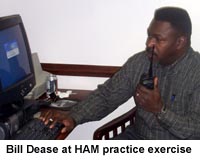 |
 |
 |
|
|
|
|
|
|
|
|
|
|
|
|
|
|
|
|
|
|
|
|
|
|
|
|
|
|
|
|
|
|
|
Posted 06/15/2006 USC project helping build radio network to help in emergencies |
|
Bill Dease of the USC Center for Public Health Preparedness says his organization has helped train some 90 HAM radio operators this year, part of a program to provide a backup communications network for hospitals and other emergency services providers. Past experience underscores the need for communications redundancy, because when breakdowns happen, “it becomes a life or death situation,” he said. S.C. hospitals have been able for some time to network over an 800 MHz radio program but the system’s reliability has led to authorities to add another layer of redundancy. Dease’s partners in helping establish the network include the Radio Amateur Civil Emergency Services (RACES), the S.C. Hospital Association, the S.C. Emergency Management Division and the Medical University of South Carolina. Dease says a Lowcountry demonstration project named the Healthcare Emergency Amateur Radio Team (HEART) has set the pattern for the statewide network. HEART was created to provide redundant radio communications for all of the medical facilities in Charleston, Berkeley and Dorchester counties The Health Resources and Services Administration is making money available through the S.C. Department of Health and Environmental Control to reimburse hospitals for much of the equipment purchased for the network which provides backup communication not only during hurricanes, but a wide array of other public health emergencies. In addition to hospitals, the network also can serve emergency shelters, 911 centers and the Red Cross. Joe Farmer, spokesman for the S.C. Emergency Management Division, said HAM radio operators, many participating through RACES, have been part of the national emergency response effort for a long time. For example, following Hurricane Katrina in Louisiana last fall, RACES provided life-saving communications when other systems faltered, he said. In South Carolina, when telephone service was destroyed by Hurricane Hugo in 1989, it was HAM radio that reestablished communication. Columbia weatherman Jim Gandy recently told a U.S. Senate Committee that the lesson from Hugo is that local and state agencies “have access to multiple communications platforms. Redundancy is critical to making sure some form of communication survives.” Charlie Miller, RACES coordinator for the SC EMD, said it is encouraging that the numbers are increasing, “but we know we don’t have enough operators” to fully staff the network. Many of the newest HAM operators are hospital workers who trained with a number of employees of the S.C. Department of Health and Environmental Control. In some cases HAMS have already set up radios in hospitals where they maintain the equipment and test it regularly. Dease said he also hopes to help integrate HAMs into emergency exercises “so that the first responders know that this asset is available. They won’t know if we aren’t there participating in the exercises.” For more information about HAM Radio operations, training and volunteer opportunities, contact:
Bill Dease, USC Center for Public Health Preparedness
Charlie Miller, South Carolina Emergency Management Division
|
|
|
|
|
|
|
|
| Columbia, SC 29208 · 803-777-7000 · info@sc.edu | © University of South Carolina Board of Trustees | ||||
 A
program to establish emergency HAM radios at most of South Carolina’s
hospitals is gaining momentum at the onset of the 2006 Hurricane Season.
A
program to establish emergency HAM radios at most of South Carolina’s
hospitals is gaining momentum at the onset of the 2006 Hurricane Season.